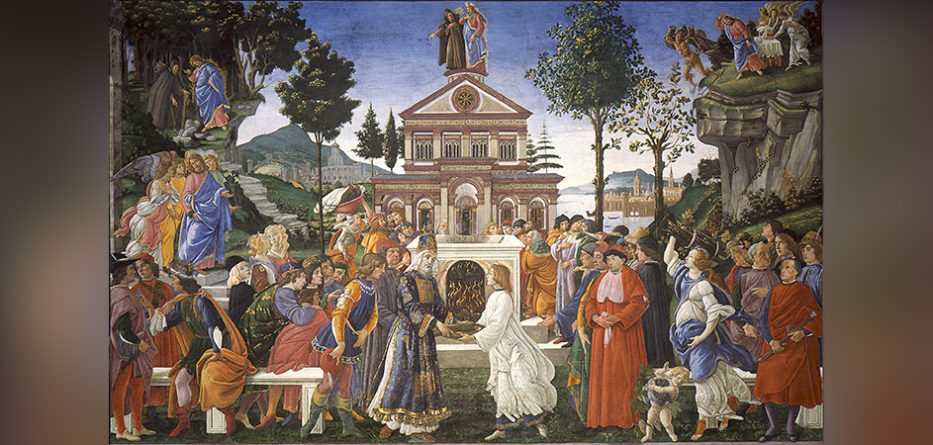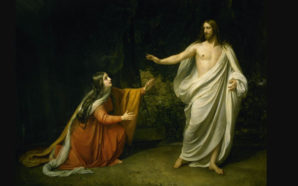First Sunday of Lent
Readings: Deuteronomy 26:4–10; Psalm 90(91):1–2, 10–15; Romans 10:8–13; Luke 4:1–13
Sunday 6 March 2022
Breaking Open the Word
In the temptations in the desert, I think the devil is subtly tempting Jesus to use divine power to win people over to God. Why would the devil do this?
In the first temptation, the devil says to Jesus: “If you are the Son of God, tell this stone to turn into a loaf.” The devil knows Jesus is hungry. The devil knows there are many hungry people in our world; hungry not just for food, but hungry with many other desires. The devil is suggesting to Jesus that he use his divine power to feed himself and others. If Jesus satisfies the hunger of people, in the sense of constantly giving them whatever they want, satisfying their desires, they will flock to him in huge numbers. But as tempting as it may be, this is not the way to win people over to God. If you bribe people to follow you, they will only follow for selfish reasons, and only when they have established what is in it for them. They will take, but will never give, and if things become difficult or if a better offer comes their way, they will leave. So, Jesus rejects this temptation. He does not want his followers to have the attitude, “What is in it for me; what can Church and society do for me?” Instead, he calls us to a life of service (Mt 20:25–28).
In the second temptation, Jesus is led to a height and is shown all the kingdoms of the world. Seeing all the problems, the conflicts, the evil in the hearts of people, it might seem impossible for Jesus to win people over to God by being loving, merciful and forgiving. And then the devil takes the opportunity. Bow down and “worship me” and “I will give you all this power and the glory of these kingdoms”, and then you can impose your own style of rule—forcing people to love and worship you. But, as tempting as it may be, if you impose your rule on others, they will resent you for it. You cannot impose God’s love on people, and you cannot force people to love God in return. If love is forced, it is not genuine. So, Jesus rejects this temptation. Jesus does not impose his rule upon us. He waits, “I stand at the door and knock” (Rv 3:20) until we invite him into our life and into the kingdom of our heart, freely opening our heart to receive his love and to love him in return.
In the third temptation, Jesus is led to the parapet of the Temple, and the devil says to him, “If you are the Son of God, throw yourself down from here.” The devil is suggesting to Jesus that if he performs an amazing stunt—an impressive show of divine power—the people will flock to him in huge numbers and will worship him like a celebrity or a superstar. But as tempting as it may be, if you do something really impressive one week, the people will expect something even more impressive the following week. If you fail to deliver, if you fail to live up to expectations, the people will get bored and will gradually drift away. So, Jesus rejects this temptation. He does not want our faith in him to be so dependent on spectacular miracles, dramatic displays of power and frequent signs (cf. Mt 12:39). That sort of faith is shallow and weak, constantly in need of reassurance. Jesus wants us to have a faith that will stand firm through the good times, through difficult times and through ordinary moments in life.
Fr Antony Jukes OFM
Artwork Spotlight for personal reflection
The Temptations of Christ (1480–1482) – Alessandro di Mariano di Vanni Filipepi (known as Sandro Botticelli (1445–1510)
The Temptations of Christ (1480–1482). Fresco, 345.5×555 cm. Sistine Chapel, Rome. Public Domain.
Practically the first word we hear during Lent is remember: “Remember you are dust, and unto dust you will return.” It is an invitation to face our mortality, and thus our true identity. Many of the scriptural themes of Lent can be traced back to the early Church. They were carefully chosen as the final instruction for those entering the Church at Easter, and thereafter as a reminder each year for all Christians of the life they had chosen. We can so easily forget. It was the rationale for the past custom of the regular parish mission for which the Redemptorists became famous. The missionaries would help us remember the basics of our faith.
Today’s Gospel reminds us that Christ identified himself with us by allowing himself to be tempted as we are. In fact, St Luke tells us that this was specifically inspired by the Holy Spirit. “[He] was led by the Spirit through the wilderness” (Lk 4:1). Scholars tell us that Luke has stylised what would have been a lifelong struggle for Jesus. Luke gives a hint by ending his account saying that the devil would return again—at Calvary, using the mockery of the Jewish leaders and the soldiers: “Save yourself” (and we will believe).
Sandro Botticelli, born probably in 1445 in Florence, was asked in 1481 by Pope Sixtus IV to come to Rome to paint some frescoes for his newly created papal chapel (since known as the Sistine Chapel). Botticelli was to paint three, among which is the one we are contemplating. (I have been to the Sistine Chapel several times and I am always amazed at the majority of visitors who go through gazing at Michelangelo’s ceiling, taking no notice of the extraordinarily beautiful frescoes along the side walls. The walls depict parallel stories—Moses on one side and Christ on the other, showing the continuity of the Old and New Testaments.)
Botticelli places Christ’s three temptations in the upper section of the fresco. On the left, Jesus, who has been fasting, is tempted by the devil, in the guise of a hermit, to turn stones into bread. The devil holds a rosary and a pilgrim’s staff in his left hand. But we can still recognise him by the wings of a bat and the feet of a vulture. The scene takes place in front of a forest of oak trees, the symbol of the Della Rovere family to which Pope Sixtus IV belonged.
Then, in the upper centre of the picture, the devil has carried Jesus to the top of the Temple at Jerusalem, symbolised here as the old St Peter’s Basilica. The devil tempts Jesus to challenge God’s promise that he will be protected by angels, by throwing himself down.
In the third temptation, on the upper right, the devil has taken Jesus to a high mountain where he shows him the beauties of the earth, and promises him their power if only he will adore him. When Jesus refuses, the devil drops his disguise and falls from the mountain. Angels come to Jesus’ aid and prepare a table with wine and bread (a forecast of the Last Supper perhaps, since the Eucharist will give us the grace to resist temptation.)
In the centre left, Jesus explains to the three angels behind him the ritual that is taking place in the foreground. (The angel in green holds a Lily and is probably Gabriel.) A man whom Jesus has healed of leprosy presents himself to the high priest so that he may be pronounced clean. He holds a basin of water in which is a branch of hyssop. On the left, a woman carries on her head a basket containing two fowls for sacrifice; on the right another woman brings cedar wood. These three ingredients were part of the ritual of cleansing a leper.
Jesus’ temptations were certainly real. The desert or wilderness was seen as a place of testing. There the people of Israel had faced God and themselves, and frequently failed the test. There Jesus, following his Baptism, faced his Father and faced himself. What was his mission and how would he carry it out? The devil suggested he not be too hard on himself nor on his followers. Use his powers and entertain the people. But Jesus would not use his powers as a personal privilege, nor would he work miracles to impress people, nor would he compromise evil. And so, the meaning of the event in the foreground of the painting. Why is Jesus pointing it out? To show that he has come not in power, but in mercy. The leper had asked: “If you want to, you can cleanse me.” Jesus replied, “Of course I want to” (Lk 5:12–13).
Lent is for us the desert we must enter for 40 days—a time to face God in prayer, a time to face ourselves. It is always good to know one’s strength and weaknesses, one’s psychological needs, one’s prejudices. The word of God, says St Paul, is a two-edged sword (Heb 4:12). Close attention to the Scriptures this season will help us separate the chaff from the wheat. “Remember your dignity, O Christian,” says St Leo the Great (Sermo 1 in Nativitate Domini).
Mgr Graham Schmitzer
Fr Antony Jukes OFM was raised in a Catholic family in Chingford, East London (the second of six children.) He was an altar server at his parish for many years, but found himself drifting from his faith during his years at university. After completing his studies, he worked as a trainee-chartered accountant in central London. It was on a pilgrimage to the shrine of Our Lady of Lourdes (France) that led him to rediscover his love for his Catholic faith and to question his vocation. His devotion to St Antony of Padua, after whom he was named, and his love for St Francis of Assisi, led him to join the Franciscan Order of Friars Minor in 2002. He studied philosophy and theology at what was the Franciscan International Study Centre in Canterbury, England, before being ordained a priest in 2009. Having served in a parish and in a youth retreat centre, Fr Antony is now the novice director at the international novitiate community in Killarney, Ireland.
Mgr Graham Schmitzer is a retired parish priest in the Diocese of Wollongong. He was ordained in 1969 and has served in the parishes of Campbelltown, Gwynneville, Unanderra, Wollongong, Albion Park, and Corrimal. He was also chancellor and secretary to Bishop William Murray for 13 years. He grew up in Port Macquarie and was educated by the Sisters of St Joseph of Lochinvar, completing his leaving certificate at Wauchope High School. For two years he worked for the Department of Attorney General and Justice before entering St Columba’s College, Springwood, in 1962. Fr Graham loves travelling and has visited many of the major art galleries in Europe.
With thanks to the Diocese of Wollongong, who have supplied these weekly Lenten 2022 reflections from their publication, Remember – Lenten Program 2022.








